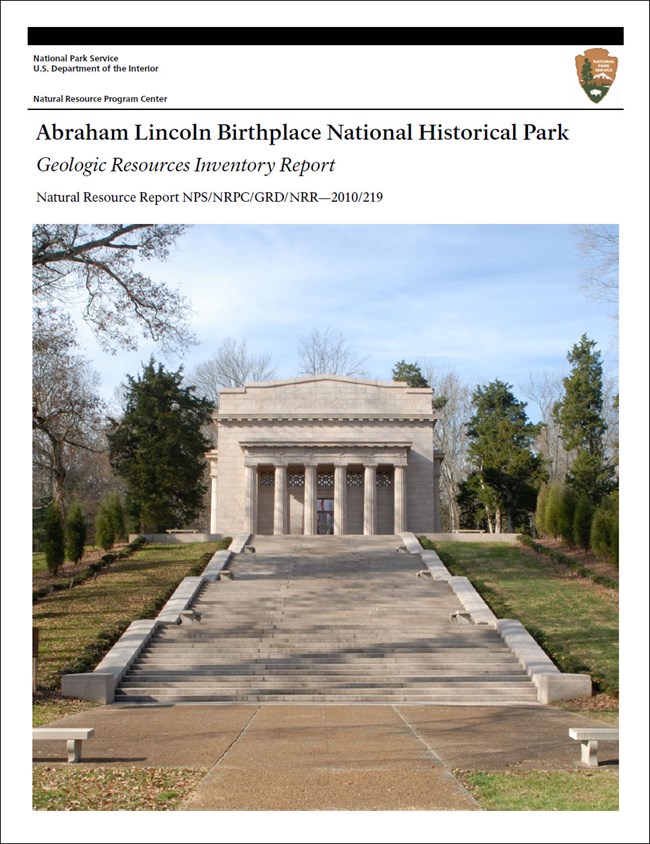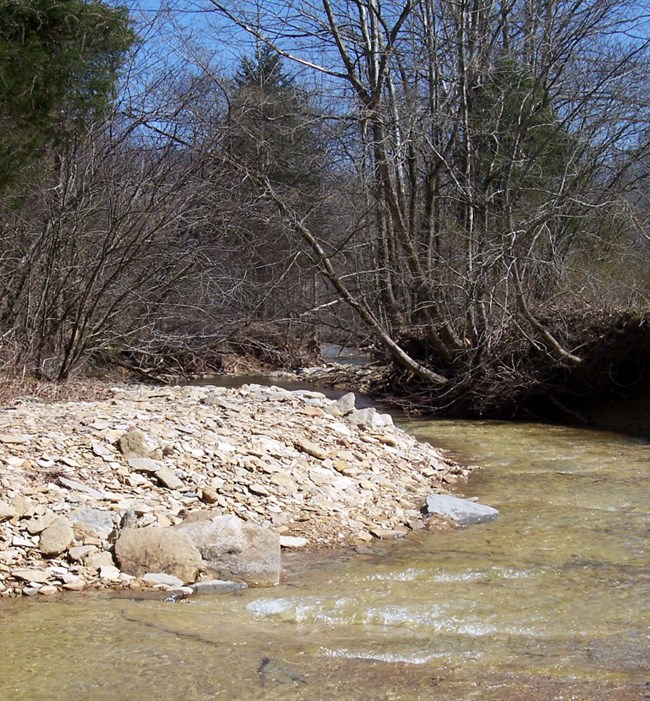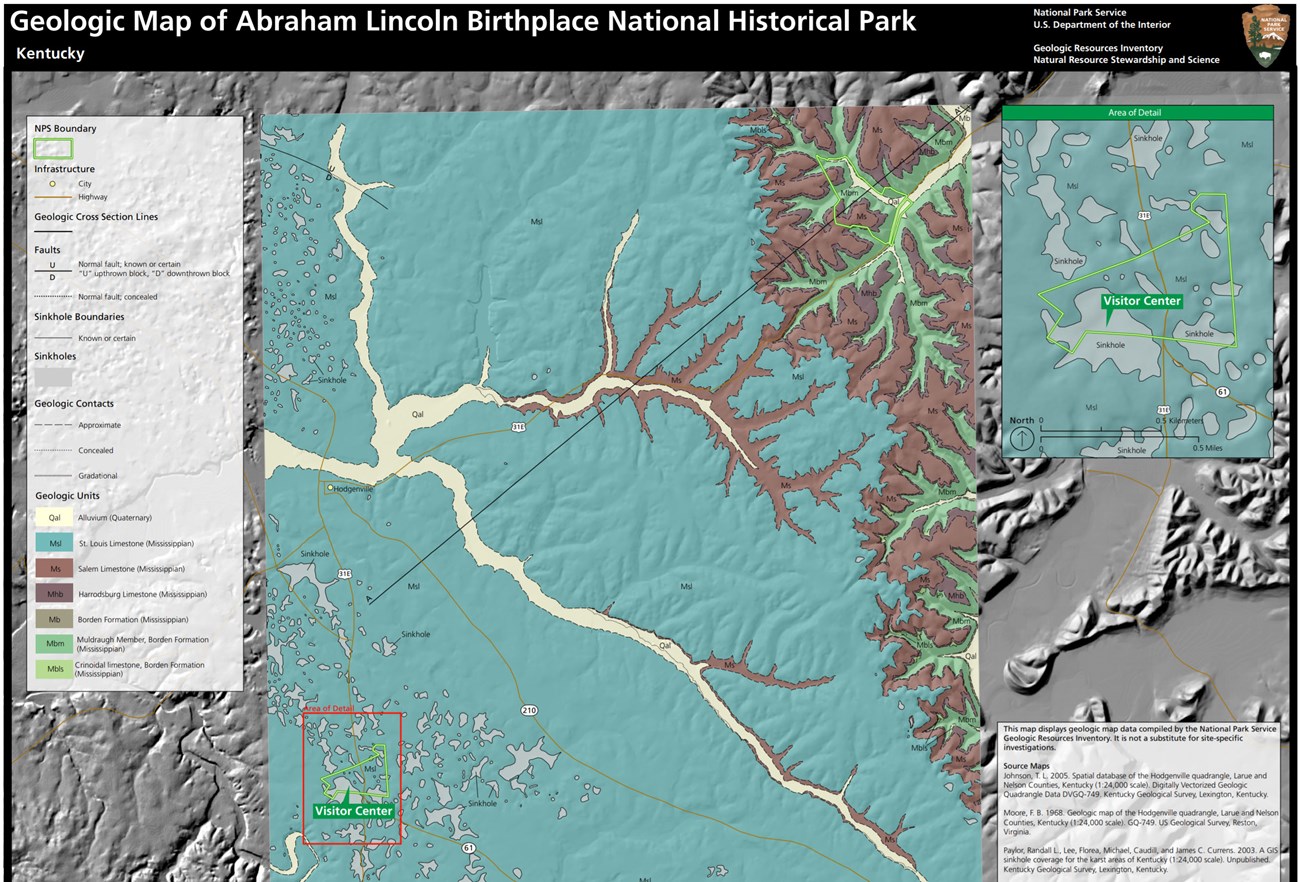Last updated: December 4, 2023
Article
NPS Geodiversity Atlas—Abraham Lincoln Birthplace National Historical Park, Kentucky
Geodiversity refers to the full variety of natural geologic (rocks, minerals, sediments, fossils, landforms, and physical processes) and soil resources and processes that occur in the park. A product of the Geologic Resources Inventory, the NPS Geodiversity Atlas delivers information in support of education, Geoconservation, and integrated management of living (biotic) and non-living (abiotic) components of the ecosystem.

Introduction
The fundamental resources at the Birthplace Unit include the historic memorial and cultural landscape, Sinking Spring, old-growth forest, and the historic Boundary Oak site (Lawliss and Hitchcock 2004). At the Boyhood Home Unit, resources include a 3-ha (7-ac) field, rural 19th century landscape, Knob Creek and its tributaries, rare limestone glades (occurring on limestone outcroppings on south- or west-facing slopes characterized by shallow rocky soils and unique flora that have adapted to the harsh dry conditions), unusually diverse and abundant flora, boundary oak, fossil-bearing Mississippian limestone, and possibly a section of the original Louisville-Nashville Turnpike (Cumberland Road) (National Park Service 2006).
Geologic Features and Processes
Abraham Lincoln Birthplace National Historical Park sits on a Mississippian-age limestone karst plain—the Pennyroyal Plateau of central Kentucky. This area is part of the ancient Illinois basin. The park and surrounding area host physiographic features associated with the geologic history of this long-standing feature on the western edge of the Appalachian Mountains, as well as the evolution of the North American continent.
Illinois Basin
The Illinois basin is a spoon-shaped, asymmetrical depression that trends northwest-southeast through Kentucky, Indian, and Illinois (fig. 12). At its deepest, the basin is filled with more than 4,300 m (14,000 ft) of predominantly shallow marine Paleozoic sediments (Maverick Energy, Inc. 2002; Swann 2007). The basin is surrounded by arches and domes. To the north lies the Wisconsin arch, to the east is the Cincinnati arch, to the southwest is the Ozark dome, to the southeast is the Nashville dome, and to the northwest is the Mississippi River arch. Depositional and erosional thinning of strata occurs from the basin center towards the basin flanks. The park is on the eastern flank of the basin. For most of the Paleozoic (especially in western Kentucky), the Rough Creek graben was the center of deposition (depocenter), and strata thickened into it (S. Greb, Kentucky Geological Survey, written communication, 2010).
Since early in its history, the Illinois basin has been subjected to repeated uplifts, downwarpings, folding, and faulting of the depositional strata. Some of the largest structures within the basin including the Rough Creek fault system have all had a significant influence on the accumulation of hydrocarbons in the basin and attest to numerous deformational (uplift) events. During the Paleozoic, the basin was open to the south as recorded by finer, deep-water sediments (Maverick Energy, Inc. 2002; Swann 2007). Deposition in the Illinois basin was mixed with erosional episodes as the basin was emergent at least 50 times and marginal areas exposed approximately 100 times during the Paleozoic (Swann 2007).
Paleontological Resources
Although not formally documented, fossils are known from bedrock within the park, including crinoids and other Mississippian-age fossils in the Borden Formation. Some crinoids may be partly intact and show some colorbanding preservation (J. Meiman, National Park Service, personal communication, 2006; S. Greb, Kentucky Geological Survey, written communication, 2010). Brachiopods, bryozoans, and corals are relatively common in the Borden Formation and might occur in the park. The Borden Formation crops out in broad areas throughout the region and generally does not contain rare fossils.
All NPS fossil resources are protected under the Paleontological Resources Preservation Act of 2009 (Public Law 111-11, Title VI, Subtitle D; 16 U.S.C. §§ 470aaa - 470aaa-11).
Cave and Karst
Karstic features influence groundwater and surface water at Abraham Lincoln Birthplace National Historical Park, and may have been important in the choice of this location as the Lincoln homestead. Sinking Spring, a perennial karst spring at the site, was the primary reason Thomas Lincoln chose to settle here in 1808 (GRI scoping notes 2006). Reliable water sources on the Pennyroyal Plateau are relatively scarce. This spring flows from a small cave and is an important interpretive feature and visitor attraction at the park (Seadler et al. 2002).
Karst aquifer systems are especially vulnerable to nonpoint source contamination (e.g., runoff from agricultural areas) because any surficial input is quickly transferred through the system with little if any natural filtering or sorption (Ryan and Meiman 1996). Agriculture, septic systems, and roadways are the primary sources for groundwater contamination in the park area.
All NPS cave resources are protected under the the Federal Cave Resources Protection Act of 1988 (FCRPA)(16 U.S.C. § 4301 et seq.).
Regional Geology
Abraham Lincoln Birthplace is a part of the Interior Low Plateaus Physiographic Province and shares its geologic history and some characteristic geologic formations with a region that extends well beyond park boundaries.
- Scoping summaries are records of scoping meetings where NPS staff and local geologists determined the park’s geologic mapping plan and what content should be included in the report.
- Digital geologic maps include files for viewing in GIS software, a guide to using the data, and a document with ancillary map information. Newer products also include data viewable in Google Earth and online map services.
- Reports use the maps to discuss the park’s setting and significance, notable geologic features and processes, geologic resource management issues, and geologic history.
- Posters are a static view of the GIS data in PDF format. Newer posters include aerial imagery or shaded relief and other park information. They are also included with the reports.
- Projects list basic information about the program and all products available for a park.
Source: Data Store Saved Search 2672. To search for additional information, visit the Data Store.
A NPS Soil Resources Inventory project has been completed for Abraham Lincoln Birthplace and can be found on the NPS Data Store.
Source: Data Store Saved Search 2685. To search for additional information, visit the Data Store.

Related Links
Related Articles
Abraham Lincoln Birthplace National Historical ParkNational Park Service Geodiversity Atlas
The servicewide Geodiversity Atlas provides information on geoheritage and geodiversity resources and values within the National Park System. This information supports science-based geoconservation and interpretation in the NPS, as well as STEM education in schools, museums, and field camps. The NPS Geologic Resources Division and many parks work with National and International geoconservation communities to ensure that NPS abiotic resources are managed using the highest standards and best practices available.For more information on the NPS Geodiversity Atlas, contact us.

